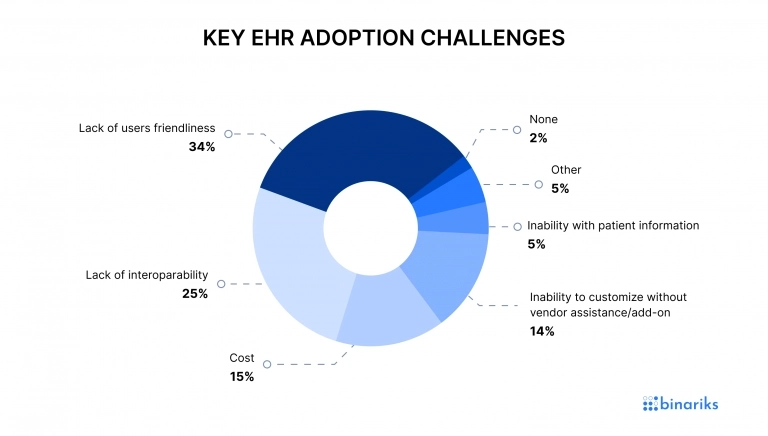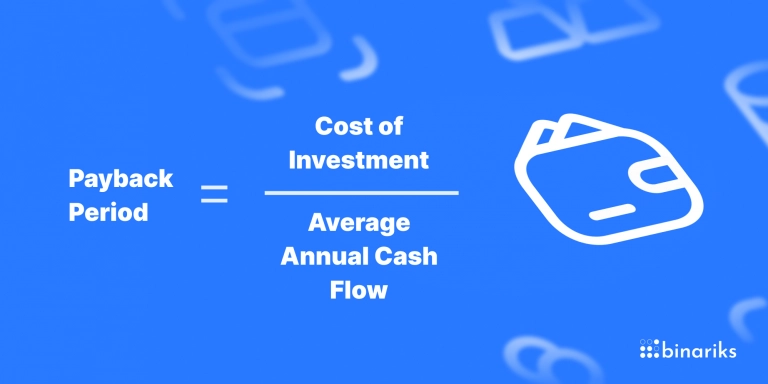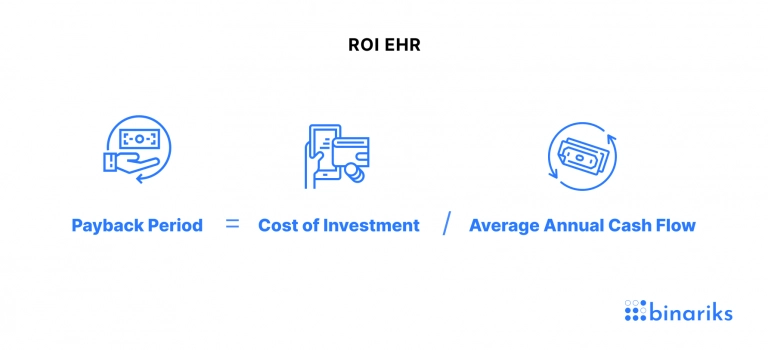Electronic health records implementation is a milestone for any medical practice. It's a five-digit investment to boost healthcare operations' effectiveness and enhance care.
The good news is EHR adoption usually pays off. The research found that, on average, primary care clinics recovered their ROI of EHR software within ten months, with a 27% increase in the active-patients-to-clinician-FTE. You can achieve even better results with the right approach to EHR use. EHR optimization, training, and regular updates maximize the return on investment for the EHR system.
Binariks specializes in providing EHR and EMR software development services aimed to help you achieve the above goals. We deliver custom solutions that answer the exact requirements of your project and can bring you long-term benefits.
Keep reading and learn how to have a higher return on investment with the use of electronic health records through the best industry practices.
ROI from EHR and EHR optimization
EHRs are an important part of the US healthcare system. They contain virtually all the information that physicians and caregivers need to know about patients, including treatment plans and healthcare services. However, just using EHRs is not enough. Understanding them and ensuring their optimization that's what's crucial.
Insufficient attention to EHR optimization leads to the accumulation of billing and coding errors, patient mix-ups, denied claims, user experience issues, and more. All these problems significantly reduce care providers' productivity and result in a poor return on investment (ROI).
That is why healthcare organizations should realize the value of EHR optimization.
For example, according to the survey of the College of Healthcare Information Management Executives (CHIME), in 2017, 38% of its members said they are prioritizing EHR optimization for their organizations (source ).
In 2022, another CHIME survey showed that 19% of the respondents were dissatisfied with their EHR system. Yet even satisfied respondents (70%) stated that some aspects of their current EHR systems wouldn't be able to meet future needs, so they must continuously evolve out of necessity.
Healthcare organizations can achieve positive ROI with EHR optimization by streamlining workflows, reducing errors, and improving communication among healthcare providers.
Besides, optimizing EHR systems can facilitate better data management and analytics, which can help healthcare organizations identify areas for improvement and build data-driven strategies.
Overall, investing in EHR optimization can lead to significant cost savings and improved patient outcomes.
The strategies organizations commonly implement to bolster EHR optimization include:
- Conducting an EHR workflow analysis
- Developing standardized documentation and templates
- Providing comprehensive EHR training to all staff members
- Implementing clinical decision support tools to improve the quality and safety of care
- Establishing internal control to help ensure the accuracy and completeness of data in the EHR system and better understand where revenue emanates from
Being relatively simple to calculate in some other industries, calculating ROI for healthcare organizations implementing EHRs can be challenging.
The thing is that assessing ROI from EHR depends on numerous factors of a particular case. And they include not only "hard" (quantitative) but also "soft" (qualitative) metrics, which are harder to measure.
Further, we will consider both quantitative and qualitative parameters in more detail and how the organization can benefit from their optimization.
Challenges of measuring ROI for EHR system
Implementing electronic health records contains many aspects; making your EHR investment pay off is a challenge. Apart from increasing the effectiveness of internal operations and automating processes, it also makes the routine tasks of physicians more convenient, enhances the patient experience, and achieves other improvements that are difficult to measure. Besides, EHR implementation and ROI include short- and long-term consequences, which means that not all the benefits will become noticeable within the first months.
So if you want to know the return on investment in electronic health records, you need a multi-faceted approach. On the one hand, it's worth relying on quantitative measures to understand how much you save thanks to the EHR and whether it pays off. On the other hand, you should research the overall qualitative impact of electronic health records on your services.

Here are some qualitative metrics you might want to track:
Enhanced quality of care
Improved services directly result from EHR adoption since electronic records make healthcare more patient-centric. They gather all critical patient information in one place, provide quick access to reports, and simplify collaboration between healthcare departments to treat patients better. Using reliable data, clinicians make more informed treatment decisions, prevent allergic reactions, reduce side effects, and enjoy other positive consequences. Despite not directly affecting the EHR return on investment, these factors significantly impact ROI of EHR software.
Fewer readmissions
Automated data analysis and patient health tracking available in advanced EHR systems help identify potential risks and prevent readmissions. After adopting predictive analytics, the University of Kansas Health System reduced the readmission rate by over 11%. The cost-saving potential is enormous because the average cost per readmission is $15,200 for all diagnoses across payers.
Illness management software linked with EHR can save healthcare expenses by $136 per person per month due to fewer hospitalizations.
Improved interoperability
Interoperability is essential for correctly implementing and configuring EHR systems, yet tricky to measure. The main point is to ensure all EHR components exchange information smoothly and securely. When the system is fast and reliable, the productivity of healthcare teams and, thus, ROI from your EHR grow.
More satisfied physicians
Although some physicians resist using EHR systems, 75% admit their positive impact.
Moreover, studies confirm the correlation between provider satisfaction and perceived patient impact. This way, physicians not only express satisfaction with EHR software but also see the positive effects of its adoption. Association between provider efficiency and satisfaction after EHR adoption.
Document standardization
EHR implementation requires keeping all documents in the same standard for easy automation that dramatically simplifies EHR data migration and processing. Thanks to templates, you speed up document procedures and facilitate regulatory compliance. Besides, 36% of physicians view documentation optimization as an opportunity to enhance the efficiency of their work. Thus, you also make medical teams more satisfied with their healthcare systems through more ordered historical patient data.
We know that measuring some qualitative EHR advantages may be challenging, but you can do it with the right approach. For example, if you want to track the quality of care, ask patients about it through surveys. Factors like readmissions or side effects can be retrieved from patients' histories.
Web and Mobile Apps for CareBridge
Binariks delivered an ectronic visit verification platform.
Three metrics to track ROI in EHR
Apart from the listed qualitative benefits, there are some quantifiable metrics to calculate the exact return on investment for an EHR system. You can use them short-term once the EHR system goes live and estimate the long-term impact later when you have enough longitudinal data.
1. Increased revenue
Growing revenue is the most apparent evidence that you are achieving a return on investment from EHR. EHR software supports advanced automation capabilities like record keeping, scheduling, messaging, etc. By optimizing these everyday processes, electronic health records allow healthcare professionals to work more effectively and see more patients within the same period. One to two additional consults per day can increase $80,000 in procedural revenues per physician (source ).
Hence, if your healthcare organization started to generate more profit after EHR implementation, you can attribute this to the tech innovations.
2. Lower expenses
Reduced spending is another reliable metric to measure EHR implementation and ROI. The research by UCSF shows that healthcare organizations that adopted EHR software managed to cut annual administrative costs up to $42,500 per FTE provider. And the fewer expenses, the higher ROI.
By implementing electronic health records, you can cut the following expenses:
- Infrastructure and administrative costs. Most modern EHR systems are cloud-based, including the commonly used EHR providers like Epic. When a healthcare organization adopts such software, there is no need to maintain on-site servers and regularly invest in infrastructure upgrades. Besides, the use of electronic records frees the space that has been cluttered with paper documentation for more cost-effective use.
- Labor costs. Medical teams work faster when powered with technology and waste less time on routine tasks. Hence, you won't need to hire additional specialists and overpay their working hours.
- IT costs. An EHR system is an all-in-one tool, meaning you won't have to manage and integrate multiple solutions. It has standardized data formats and transparent workflows to simplify IT maintenance and cut related expenses.
- Human error costs. With an EHR system, healthcare professionals are less prone to making mistakes that may result in financial losses. By preventing them, you also save money that could be lost due to mistreatment or data leakage.
3. Operational efficiency
The third category of metrics to measure the ROI of EHR software is operational efficiency stemming from electronic health records adoption. Advanced software allows healthcare organizations to track bed availability and patient flow to redistribute resources. They can also utilize equipment more efficiently by scheduling and analyzing usage data. These and other indicators can reflect return on investment. When the performance of your internal systems is good enough, the return on investment also increases.
Planning to create a new healthcare app or modernize the existing one? Look how we can help!
Potential risks to investment in EHR/EMR
Here are a few potential challenges to EHR and EMR usage. Learning about them might help you avoid issues in achieving a high return on investment from EHR.
Technical expertise
The capacity of a computer to gather and communicate data across healthcare is impacted by its age and other factors, such as the location of the practice. Connecting to the system and the internet might be more challenging in a rural environment than in an urban setting. Ensure that your office location will make EHR deployment a stress-free experience for you.
Usability
Some medical practices may find it challenging to understand how to use the EHR system without sufficient training. Sometimes the issue is not with human mistakes but with the system itself, which may have a cumbersome interface with difficult-to-find settings.
You require an EHR system that is simple to use and navigate for your staff.
An EHR may be more challenging for your team to utilize at first than a paper-based system. However, with time and training, the impediments will fade, and you will discover that EHR systems are far more efficient.
Violations of security and privacy
While most EHR systems are safe and secure, doctors and practice managers are nevertheless concerned about data breaches caused by ransomware and other cybersecurity breaches.
Most practices encounter privacy risks, including data tampering, data loss after a natural disaster, and illegal access to patient information. Your reaction should be to consider such dangers when deciding on a security policy. Work with your software provider and IT staff to detect bugs as you strengthen the firewall.
Migration of time and data
When you install the EHR software, you will have large paper patient records that you will need to enter into the system. It might take time to transcribe paper records into an EHR system. Someone will have to enter it, and the danger is that medical practitioners will lose information.
Using optical character recognition software is one way to speed things up. The program turns the text and numbers in the paper document into machine-readable data when you scan it. While the process is primarily automated, you will still need to watch it and check files to ensure there are no errors in word recognition.
Interoperability
Of course, your new EHR software system will not be the only one running in your busy medical office. A significant issue you should consider when acquiring your EHR program is a lack of interoperability. Your team cannot share patient information until this feature is enabled.
Having your IT staff confirm that the EHR software is compatible with all other systems, such as practice management software or custom software designed specifically for your business, is a good idea.
There is always a chance that the investment will not return, but to avoid these risks, pay attention to our tips on maximizing return on investment with the use of electronic health records.
HIPAA Rule for Software Development
Learn how to create HIPAA-compliant healthcare solutions!

Tips on how to maximize EHR ROI
Understanding what metrics show achieving ROI from EHR is vital. You should rely on these indicators to check how EHR implementation and ROI are interrelated and measure the impact. If you find out that the integrated EHR system doesn't perform as expected, there are ways to fix it.
Here are some tips to maximize the electronic health record's return on investment:
- Start optimization four to six weeks after go-live. Nuance Communications executive director and CMIO Bret Shillingstad, MD noted that four-six weeks is the optimal period to start measuring how software implementation affects your revenue. This way, you can record the short- and long-term impact.
- Ensure interoperability and centralized operations. Electronic systems show the best results when all their components exchange data smoothly. Hence, interoperability might be problematic if your ROI is not as good as you want.
- Pre-fill frequently used information. Speed up the routine tasks of healthcare teams and patients by automatically entering details in forms, reports, and other templates.
- EHR data and operations to the cloud. "Cloud-based systems are where the IT industry is going," said Paul Winandy, CEO of physical therapy software WebPT. If you have server-based healthcare systems, consider moving them to the cloud. It will simplify updates, enhance scalability, optimize operations, and bring many other benefits, including reduced costs.
- Implement additional features. After auditing your current software, it may turn out you lack some useful features. Then, you can consult EHR vendors on what add-on would be the most relevant and bring the maximum value.
- Continuously update the EHR. Regular updates are essential even after EHR implementation. "It's important to upgrade to the latest version to improve your organization's efficiency and achieve your goals," said Paul Black, CEO of Allscripts. Besides, he noted that timely updating of the EHR system is crucial because of the changing regulatory requirements the organization needs to meet.
- Train your personnel. You must ensure your team leverages all software capabilities and knows how to do it. Hence, conducting practical training for different departments and monitoring the system's use is vital. As Zachary Blunt , the manager of product management population health at Greenway Health, noted: "all users should have an understanding of how their roles factor into the overall success of the system and the practice at large."
- Improve EHR data quality and value. Also, Zachary Blunt said that all EHR systems contain valuable data that can improve ROI if unlocked effectively. Analytics can help to get insights on value-based programs, billing optimization, cash flow, and population health initiatives. Investing in staff with both technical and clinical skills is the key to accessing these insights and maximizing ROI from EHR systems.
- Reduce patient cancellation rates. WebPT co-founder and chief clinical officer Dr. Heidi Jannenga said that automating the appointment reminder process can lead to a better bottom line. Studies show that using texts, emails, and other automated reminders significantly impacts cancel and no-show ratios, which are crucial performance indicators. By increasing the arrival rate, clinics can boost revenue.
- Find a tech partner and consultant. An EHR development and optimization process is challenging, so you should find someone to guide you through it. A software development company with healthcare expertise like Binariks can advise you on the best ways to maximize EHR ROI in your case and assist with related tech issues.
These basic steps considerably impact the efficiency of EHR implementation and ROI. Once you follow them, you will see an increase in return on investment in EHR software.
Calculate the ROI of EHR system
Your hardware expenditures should include not just the cost of your system but also software upgrades, investments in additional systems, servers, electricity, and system backups, as well as license fees and subscription payments.
The indirect or induced costs of using an EHR include establishing the system, training personnel to use your EHR, and paying for tech support and maintenance. Even though most medical offices sign an annual maintenance contract with suppliers, post-implementation servicing leaves much to be desired. As a result, medical offices are hiring a full-time EHR specialist to create templates and troubleshoot technological issues. All costs related to it must be quantified to determine the true "cost" of your EHR system.
The amount of time it takes to earn money invested in EHRs
Most medical offices may repay their investment funds within a few months.
The general formula for determining how long it takes to recover the initial costs associated with an investment is the following:

Payback Period = Cost of Investment/Average Annual Cash Flow
Along with a formula to assess ROI from EHR (ROI = Net Profit/Cost of Investment x 100 ), knowing the payback period can help to make a quick judgment about an investment venture. Investments with a shorter payback period are typically considered less risky.

Another metric that allows evaluating an investment in terms of time is a break-even point.
The break-even point defines when an investment will generate a positive return. It is defined as the number of months it takes an organization to recover the cost of the EHR system and associated costs, with increased revenues and/or decreased expenses.
The formula for calculating the break-even point of an EHR implementation in a clinic equates the cost of implementation to the difference between the clinic's net revenue between the pre-EHR and peri-EHR periods plus the difference in net revenue between the pre-EHR and post-EHR periods:
CEHR=[(NRperi-NRpre)/12]Mimp + [(NRpost−NRpre)/12](Mbreak-even−Mimp) (source )

In this formula: CEHR = cost of EHR implementation; NRperi = annual clinic net revenue in the peri-EHR period, NRpre = annual clinic net revenue in the pre-EHR period; NRpost = annual clinic net revenue in the post-EHR period; Mimp = the number of months taken to complete the EHR implementation; Mbreak-even = months to break even.
Improvements in cash flow and process following EHR installation
Cash flow increments are difficult to come by in the first few months because the massive changes an EHR brings to the table may wreak havoc on a medical practice's financial flow.
Most medical offices like the faster, more automated, and more integrated workflow that EHRs provide. To better appreciate the changes in workflow that your system has brought to your practices, and if they are for the better, examine the key components that comprise your daily clinical workflow.
Divide it into essential sections such as
- Number of patients encountered
- Time spent on average per patient visit
- Utilization of Resources
- Time spent documenting medical data
- The time it takes to bill for services
- Coding precision
- Cycle time for a patient
Read also: How to integrate EHR in medical billing
The importance of EHR optimization
We've discussed several essential benefits that EHRs may provide. Still, to improve patient care and obtain a favorable ROI, institutions must perform EHR optimization.
Only digital systems are unquestionably beneficial: in a 2017 Medical Economics poll, many physicians stated that EHRs were detrimental to their practice. They discovered several pain points, including a lack of usability, interoperability concerns, and the inability to personalize the system. As a result, it is unquestionably vital to be able to critically examine a current EHR system and continue to optimize it regularly.
EHR optimization entails addressing these issues using the following factors:
Long-term development strategy
There is a five-step maturity curve for EHR adoption to achieve EHR ROI. They allow us to retrieve actionable insights and elevate patient experience. Only when EHR is an integrated platform that physicians and nurses use consistently in their daily workflow, can it become a useful data source.
Customization
You can enhance service quality by tailoring it to the specific needs of EHR to improve service quality and increase ROI. No off-the-shelf system can predict which characteristics will be used. These tools can only help generate distinct insights from EHR data and produce financial advantages when used with a specific workflow.
Training
Medical experts believe that investing in EHR user training is critical for getting the most out of the system. Only when all staff members and patients understand and use all functions, can EHRs contribute to operational efficiency.
Scalability
The EHR system must adapt to changes and extend features as needed. Scalability is about the ability of products to process more data. This is important because hospital owners need to know that the solutions will serve for an extremely large patient base.
As we can see, combining the proper software and training leads to favorable results in EHR use.
Case studies of achieving ROI with integrated EHR
Here are a couple of real examples showing how different healthcare organizations can achieve a positive ROI from an EHR system implementation.
IRCCS-ISMETT transplant institute, Italy
IRCCS-ISMETT, an Italian transplant institute, implemented an electronic health record (EHR) system integrated with a data warehouse (DWH) to improve patient care and optimize hospital resources. The system allowed for real-time access to patient data, streamlined communication between departments, and reduced errors and redundancies.
Cash flow analysis of the EHR-DWH implementation showed a return on investment (ROI) of about 25.51%, and the payback period was four years.
The EHR system also contributed to a reduction in patient length of stay and improved patient outcomes. This case study highlights the benefits of implementing an integrated EHR system for healthcare organizations in terms of financial gains and improved patient care.
Tertiary hospital, Malawi
Another study is focused on how hospitals in low-income areas could have good ROI from an EHR implementation. The researchers studied the impact of a hospital-wide EHR implementation in a tertiary facility in Malawi, southeastern Africa.
As such hospitals have additional problems that may affect ROI from EHR systems (for example, staff and supply shortages), only three areas of impact were evaluated: the length of stay, transcription times, and lab use.
Estimated cost savings totaled $284,395 per year. Over five years, the estimated net benefit was $613,681, showing that EHRs can have both clinical and financial benefits in low-income settings.
The study's authors conclude that the focus should not be on whether to make these investments but on how to make them. They note that the ROI indicator of an EHR depends on multiple factors of a particular case and warn against a lack of research and training before purchasing an EHR.
Consider Binariks as your trusted tech partner
Binariks is a custom healthcare software development company that provides software creation, migration, and optimization services. Being an AWS consulting, Google Cloud, and Microsoft Gold partner, we can help you with cloud EHR implementation.
Besides hiring skilled software engineers, we also have experienced business analysts and QA engineers on board. While business analysts can do financial estimates for you, QA specialists check whether the implemented electronic health records operate correctly.
Binariks always assembles a dedicated development team based on your project needs. Contact us now to achieve the optimum EHR ROI with our help.
Top EHR ROI questions
Share

